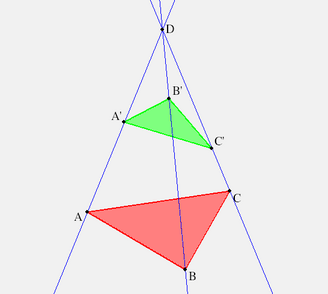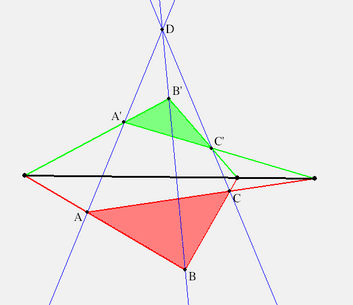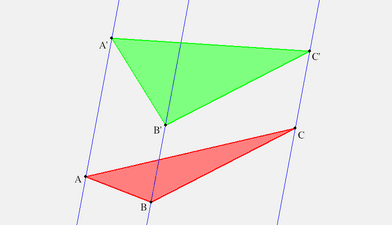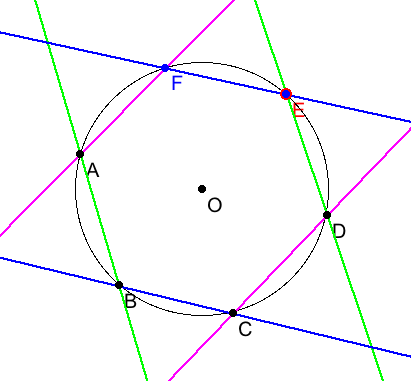Geometers call the set of all lines through a point a pencil of
concurrent lines.
Johannes Kepler (ca 1600) had the idea of extending this concept to all
lines parallel to a given line as the pencil of lines concurrent at an
ideal point.
The stars, which for astronomer Kepler were infinitely
far away, became the physical representations of the ideal points. So we
also call them points at infinity. Like real (or finite) points,
ideal points could lie on an ideal line insofar as the lines in
each pencil are all parallel to the same (real) plane. Modern geometers
prefer to define new objects in terms of sets of points.
Definition.
An ideal point $ X $ is a set of lines parallel to a line.
By $ (\ell X) $ we shall mean that $ \ell \in X $.
In the plane, the set of all ideal points comprise the ideal line,
$ \infty $. Thus every line $ \ell $ has an ideal
point on itself, $ X = (\ell \infty) $, and two lines are
parallel if and only if they meet at infinity:
$ \ell || k \equiv (\ell \infty) = (k \infty) $
Question.
In space we have many ideal lines, one for each set of all
mutually parallel planes. The ideal lines comprise one ideal
plane, Kepler’s firmament of stars. Given two geometrical objects
taken from the set of points, lines and planes, where do they
meet?
Two non-parallel planes meet along a line. Two parallel planes now meet
along their common ideal line. A plane and a line (that does not
lie in the plane) must meet, either where the line pierces the plane.
Or, if the line is parallel to the plane, they meet "at infinity", i.e.
the ideal point of the line lies on the ideal line on the plane.
Two lines, however, need not meet at all, either at any real point
or at any ideal point. Such lines are called skew.
Can you figure out what it means for a real and an ideal line
to be skew?
Kepler’s peculiar geometry had already been discovered,
practically speaking, by the Rennaissance artists in
their study of perspective. The horizon,
particularly familiar for residents of Illinois, is an ideal line. In
perspective, the horizon is drawn as a line in the painter’s canvas.
Later, these ideas were adopted by mathematicians as
projective geometry. It differs from the traditional Euclidean
geometry in many ways. Most notably, there is greater logical
symmetry between points and lines.
In projective geometry, any two points are joined by a line ( as they
do in Euclid’s geometry)
and any two lines (in a plane) have a point in common (non-Euclidean).
In projective 3-space, any two points are joined by a line (Euclidean),
and any two planes meet along line (non-Euclidean).
To exercise this expanded way of thinking we re-examine Desargues'
theorem, but allowing for certain points to be ideal.
The figure we usually draw to illustrate Desargues Theorem looks
like the following. But you should experiment with figures where
the red and green triangles are in more general positions along the
three lines.

|
Click image to view desargues1.seg with KSEG. |
|

|
Click image to view desargues2.seg with KSEG. |
|
Now let’s look at one ideal case, when both $ D \and A^** $
are idea, i.e. $ (A'A) || (B'B) || (C'C) \and (BC) || (B'C') $.

|
Click image to view desargues3.seg with KSEG. |
|
In this case, we have three parallal lines supporting the two triangles.
`C^{**}=(A'B')(AB), B^{**}=(C'A')(CA)` are real (draw them !)
but `A^{**}=(B'C')(BC)` is ideal. Now what does the conclusion of
Desargues' theorem, that `(A^{**}B^{**}C^{**})`
is a line, mean in purely Euclidean terms?
It means that `A^{**}` is on `(B^{**}C^{**})`,
i.e. that `(B^{**}C^{**})` is a line parallel to
(both) `(BC)` and `(B'C')`.
In other words, `(B^{**}C^{**})` is in the pencil of
`(BC)`.
Exercise.
Easy: Give a similar description of the case that only $ D $ is ideal.
Challenging: What if only $ A $ is ideal?
Next, let’s play this game in reverse, and see what happens when ideal
points are made real. Here is a classical theorem about parallel lines
(see Tondeur, Chapter 1).
Having extended the concept of collinearity to include ideal and
real points in the plane, you should revisit Pascal’s generalization of
Pappus' theorem we mentioned earlier. Pascal was so amazed by the
result he discovered, he gave it a fancy name:

|
Click image to view hexagrmmum.seg with KSEG. |
|
The circle is a well-known conic section, as are two crossing lines.
In Kepler’s sense, two parallel lines are also qualify. They are a section
of a cylinder, and a cylinder is a cone with its vertex at infinity.
The intersections of the three pairs of opposite sides of a regular hexagon
are ideal, and hence collinear.
Inscribe a hexalateral in a circle, and see where these
three points are now? Don’t be afraid to have sides of the polygon cross.
Move one vertex of the hexalateral off the circle and see what happens.
Finally, move all the vertices of the polygon off the circle, but carefully
perserving the collinearity you’ve observed. Any conjectures about where
these vertices must lie?




